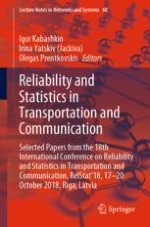2019 | Buch
Reliability and Statistics in Transportation and Communication
Selected Papers from the 18th International Conference on Reliability and Statistics in Transportation and Communication, RelStat’18, 17-20 October 2018, Riga, Latvia
herausgegeben von: Prof. Igor Kabashkin, Prof. Irina Yatskiv (Jackiva), Prof. Olegas Prentkovskis
Verlag: Springer International Publishing
Buchreihe : Lecture Notes in Networks and Systems
